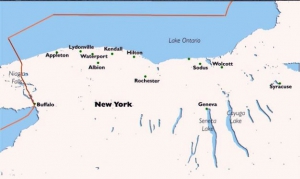
IFTA members toured 14 orchards in an area along Lake Ontario’s south shore, where nearly 29,000 acres are devoted to tree fruit production.
Western New York’s assets were on display for three days as about 200 fruit growers from around the world viewed thousands of acres of modern orchards. These orchards are tended by an increasing number of growers from the next-younger generation and supported by a strong land-grant university filled with people with good ideas and international reputations.
Signs were everywhere:
Next generation: Young growers wore blue tee shirts emblazoned with the logo of the newly formed Future Fruit Growers of Lake Ontario. It has about 30 members now, mostly sons and daughters of established fruit-growing families. Two other chapters are forming in the Hudson Valley and Lake Champlain Valley fruit areas.
Machinery: Growers are trying new machines, many of their own invention or modification—fruit thinners, orchard platforms, tree hedgers, bin haulers, trellis post drivers and wire stringers, innovative new sprayers, new harvesting methods, and on-farm solar and wind power generators.
Tall spindle: High-density orchards are the mode, most of them of the tall spindle design inspired by the work and exhortations of Cornell University horticulturists Dr. Terence Robinson and Steve Hoying, who perfected the system. Trees planted at 1,100 or so per acre are being pushed to the top wire of a 10-foot trellis in two years, and some orchards have accumulated a thousand bushels of fruit per acre by the end of their third leaf.
Knip trees: Chip Bailey, at KC Farms in Wayne County, planted knip boom Galas on M.9-Nic. 29 and set a New York State record for the first two crop years, according to Robinson. He grew 240 bushels per acre in the second leaf and 960 in the third.
“I’m going to best that myself in my new planting,” Bailey said.
Robinson is a fan of knip trees, which spend an extra year in the nursery and cost about $1.20 more each, plus additional freight costs because of their larger size. “They’re harder to handle,” Bailey said, but Robinson added: “It’s an instant orchard.”
Trellises: Growers are using new twists in trellis systems in which cheap, soft wire is used as a vertical stabilizer instead of bamboo or conduit stakes. New York growers often use locally produced black locust and red pine trellis posts instead of more expensive yellow and lodgepole pine posts from the South.
At Fowler Orchards, visitors saw a front-end loader post driver that vibrates and pushes trellis posts into the ground rather than pounding them. Robinson explained that red pine posts are cheaper, but they branch in ways that put too many knots together at one height and they can break when pounded. They can be pushed into the ground if they are vibrated. Fowler Orchards also uses rot-resistant black locust for posts.
New varieties: Growers are planting modern fresh-market apple varieties—not just Honeycrisp and SweeTango—but the newest New York 1 and New York 2 from Dr. Susan Brown’s breeding program at Cornell University. They plant numbered strains of new varieties, testing them out on customers at farm and farmers’ markets. Grower interest in new varieties—and their involvement in helping bring Cornell varieties to fruition—was evident on many farms.
Rootstocks: New rootstocks solve problems. The Geneva Experiment Station, and the USDA breeding program there led by Dr. Gennaro Fazio, has introduced and is promoting new rootstocks that are resistant or even immune to fireblight and replant disease.
Infrastructure: New pesticide storage sheds and containment facilities for mixing and filling sprayers show grower desire for safety and environmental protection—and their cooperation with government incentive programs designed to help build them.
In other ways, too, infrastructure is developing. Growers have organized themselves into cooperatives that pack the fruit for distribution to fresh-market retailers. New York City, the Big Apple, is a good market for growers, and many bring their apples direct to consumers at the city’s established Greenmarket network.
New York growers are moving away from growing apples for the processing market and thus need a new packing and distribution system.
Pest management: Growers are attacking their multifaceted pest complex in new ways. While slow coming to New York, an areawide mating disruption program for codling moth and oriental fruit moth is in its third year.
Deborah Breth, an entomologist with Cornell’s Lake Ontario Fruit Team, worked with four growers and 150 acres of adjoining orchards starting in 2008. These orchards had experienced load rejections of processing apples, where tolerance for fruit worm pests is low or even zero. While first-year costs were high, the combination of mating disruption pheromones and targeted insecticides cut damage to zero and dropped control costs to acceptable levels by the third year.
“In 2008, growers spent nearly $300 per acre managing codling moth and oriental fruit moth, including five to six insecticides and pheromones,” Breth said. “In 2009, growers reduced insecticide applications to three or four, reducing costs to $216 to $250 per acre. This season, we reduced the rates of pheromones by 25 percent. Mating disruption pheromones made this high-pressure site into a low-pressure site.”
Irrigation: More growers are using irrigation. In New York, rainfall totals run from 30 to 50 inches, well distributed throughout the year. But the move to high density plantings of trees on less vigorous rootstocks has led to greater use of trickle irrigation, especially for young trees.
Determining water needs by trees on heavy soils and in a moist climate has proven difficult. Dr. Alan Lakso, a horticulturist at Cornell, is enclosing trees in balloons of plastic wrap and inserting probes into their trunks in order to accurately estimate water needs.
“We have measured actual water use and developed a water-use model specific to apples in our climate,” he said. Growers are testing the model in their orchards.

Leave A Comment